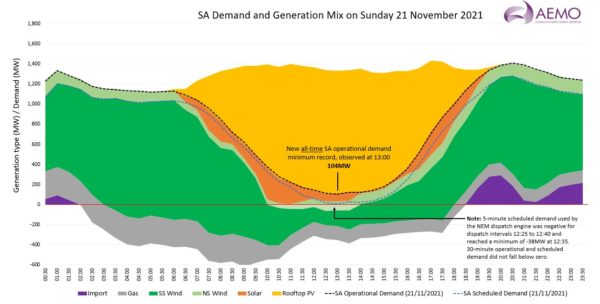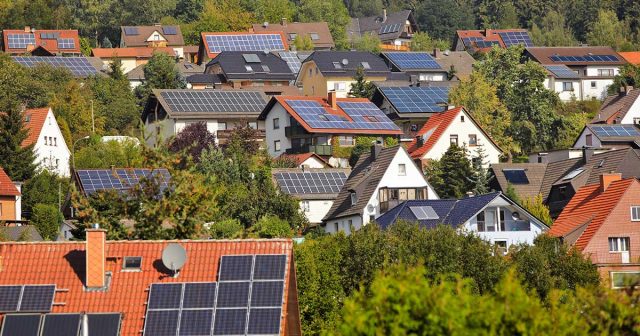Last Sunday, November 21, a glorious late spring day, South Australia (SA) became the first gigawatt scale grid on the planet to hit zero operational demand, and it has rooftop solar to thank. The achievement came via two negative demand events in the early afternoon which surpassed the previous minimum demand event on September 28, 2016 (the infamous day of the SA system blackout).
However, there was no such blackout this time. The first event took place between 12:20-12:50pm early Sunday afternoon, reaching a minimum of -46.4 MW at 12:35pm. The grid then went negative again from 13:25-13:50, reaching a minimum demand of -15.4 MW at 13:40.
Reaction
Energy analysts throughout the industry reacted sprightly to the event, describing it as a world-first. Or, to put it in the words of Jess Hunt, senior advisor with the Energy Security Board (ESB), “Crickey! South Australia’s electricity demand went negative today…not really of course, but our rooftop PV output exceeded native demand and the remainder was exported interstate.”
Hunt noted that if such a negative event were to happen on a grid-wide scale, “the lights will go out…it’s physics”, but thankfully for the moment that surplus can be sent interstate. “In a few years, the eastern States will have a surplus too at ceratin times,” Hunt continued, “so we’re building the capability to remotely switch off rooftop PV in an emergency, as well as looking at other ways to get value out of the energy so we don’t end up wasting it.”
WattClarity’s Paul McCardle described the event as a “new low point”, and he didn’t mean it pejoratively. McCardle observed “One significant thing that has changed in the intervening 3 weeks is that the fuller effect of South Australia’s synchronous condensers are being felt, allowing thermal units to be backed off further than was previously the case. We can see this in this snapshot from NEMwatch for the 11:25 dispatch interval (NEM time) today.”
McCardle also pointed out that wind generation has been ramping down in SA, “which may be in part due to the sub-zero prices that South Australia has been experiencing as rooftop PV cleans up the lion’s share of underlying demand.”
Minimum SA Network Demand of -46.4 MW at 12:35 hrs Sun 21-11-2021 .. https://t.co/ZbeIBRWzD9
Previous was 4.89 MW (51.24 MW higher) at 16:25 hrs Wed 28-09-2016 .. https://t.co/ZbeIBRWzD9 #NEMrecords #NEMrecord #sa_network_demand_min_instant_all pic.twitter.com/IZSMGgHJVb
— eljmkt_nemlog (@eljmkt_nemlog) November 21, 2021
According to the Australian Energy Market Operator (AEMO), which has been expecting such an event as it seeks to cope with increasing PV integration, “Rooftop solar provided 92% (at 1,220 MW) of South Australia’s electricity needs on Sunday, helping set a new minimum demand record of 104 MW from 12:30-1pm – down 45% from the previous record of 188 MW on 31 October 2021.”

These events are unlikely to remain anomalous, especially as Australians are only continuing to install rooftop solar systems. And while system operators like AEMO hustle to come up with mechanisms to enable the grid to deal with such influxes of solar energy, negative events emphasise the need for battery storage and other such solutions to help spread Australia’s excess of solar energy.
This content is protected by copyright and may not be reused. If you want to cooperate with us and would like to reuse some of our content, please contact: editors@pv-magazine.com.









3 comments
By submitting this form you agree to pv magazine using your data for the purposes of publishing your comment.
Your personal data will only be disclosed or otherwise transmitted to third parties for the purposes of spam filtering or if this is necessary for technical maintenance of the website. Any other transfer to third parties will not take place unless this is justified on the basis of applicable data protection regulations or if pv magazine is legally obliged to do so.
You may revoke this consent at any time with effect for the future, in which case your personal data will be deleted immediately. Otherwise, your data will be deleted if pv magazine has processed your request or the purpose of data storage is fulfilled.
Further information on data privacy can be found in our Data Protection Policy.